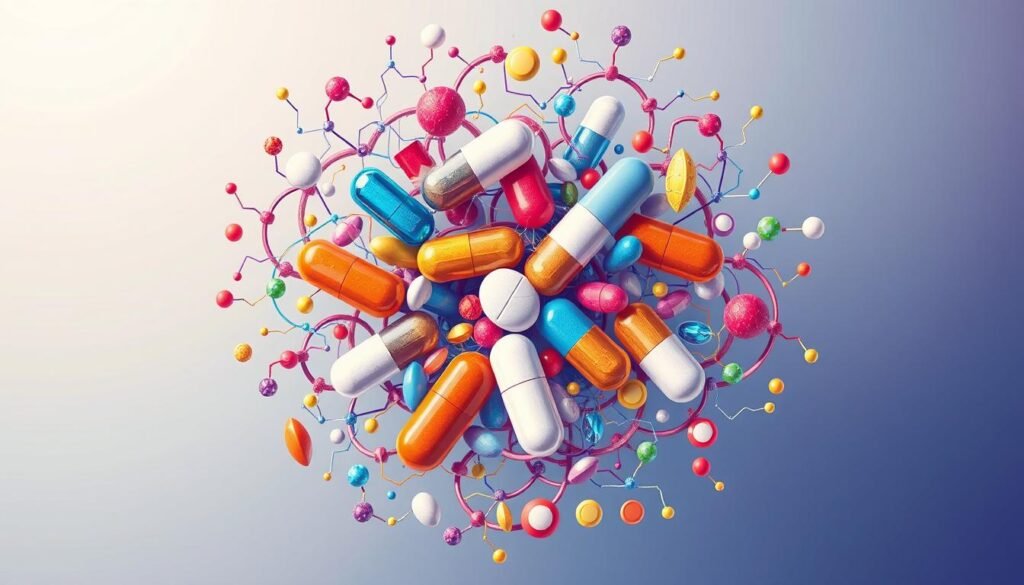Did you know that about one third of patients treated for depression see no improvement with conventional meds? This fact shows why it’s important to look into combining treatments for better results. While some may get better within 2-8 weeks, fully overcoming depression can take much longer. It could last from 4-6 weeks up to several months. So, finding ways to make treatment more effective is key for people with major depressive disorder (MDD).
Looking into combining treatments offers more than the usual methods. By knowing how different meds work together, and adding other types of therapy, doctors can help patients more. They can make treatment more effective and easier to handle. As ways of treating depression grow, finding these combinations gives new hope. It helps those who are battling MDD and searching for better paths to wellness.
Key Takeaways
- About 33% of depression patients may not respond to traditional treatments.
- Synergistic strategies can enhance therapeutic effects.
- Full remission in depression treatment can take weeks to months.
- Combining therapies may improve efficacy and tolerability.
- Potential new approaches are critical for patients with MDD.
Introduction to Major Depressive Disorder
Major Depressive Disorder (MDD) is a severe mental health issue. Millions around the world suffer from it. Understanding its impact is crucial for everyone.
Early detection can make treatments more effective. It’s vital to know how widespread and influential MDD is.
Understanding the Prevalence and Impact of MDD
About 5–20% of people worldwide are hit by depression. That’s over 264 million people facing MDD. The World Health Organization sees it as a significant mental illness.
It heavily affects daily life, disturbing sleep, eating, energy, and mood. Many don’t get the treatment they need. Getting help early can change lives.
For more information, see this research article.
Common Symptoms of Major Depressive Disorder
It’s crucial to spot MDD symptoms early. They include:
- Persistent sadness
- Fatigue or loss of energy
- Diminished interest or pleasure in activities
- Changes in appetite or weight
- Sleep disturbances
Recognizing these signs can lead to early help. This can greatly improve lives.
The Pathophysiology of Depression
Understanding depression is complex. It involves biology, psychology, and environment. The monoaminergic hypothesis suggests a key idea. It says a lack of neurotransmitters like serotonin, norepinephrine, and dopamine is important. But this idea doesn’t cover everything. Other factors like chronic stress and neuroinflammation also play roles.
Monoaminergic Hypothesis of Depression
Research has focused on the monoaminergic hypothesis for years. It explores how serotonin, norepinephrine, and dopamine affect depression. Though widely accepted, this view has its limits. Not everyone responds the same to treatments, showing depression’s complexity. This has led to looking into other theories.
Neurotrophic Hypothesis: Role of BDNF and TGF-β1
The neurotrophic hypothesis shifts the focus. It looks at neurotrophic factors for understanding depression. BDNF and TGF-β1 are vital for neuron health and synaptic plasticity. Stress can lower BDNF levels and change TGF-β1. This leads to neuron damage in mood-related brain areas. Such damage then worsens depression.
Studies suggest that improving BDNF and TGF-β1 levels helps fight depression. Knowing these pathways helps scientists make new treatments. These can target the synaptic problems caused by stress. The goal is to find better ways to help those facing major depressive disorder.
Synergy with Antidepressants: What It Means
Understanding how antidepressants work together is key to treating major depressive disorder better. This “synergy” means that using different treatments together can have a stronger effect than using them alone. By doing this, doctors can make antidepressants work better, helping patients feel better faster.
Defining Synergy in Antidepressant Treatments
Synergy in antidepressant treatments happens when using more than one method at the same time. For instance, adding another drug to a traditional antidepressant can make it work better. This is especially true for people whose depression doesn’t get better with just one medicine. Studies show that combining treatments can really help these patients.
Potential Benefits of Synergistic Strategies
Here are key benefits of using a combined approach:
- Increased Efficacy: Using different treatments together can deal with more symptoms than just one.
- Enhanced Tolerability: This method might also mean fewer side effects because lower doses of antidepressants can be used.
- Targeting Treatment-Resistant Cases: It’s a new hope for those who didn’t improve with their first treatment.
When about one-third of patients don’t get better with their first medication, knowing how to use treatments together is crucial. This knowledge can majorly boost their life quality. Learning from recent research, like the studies by Bahar et al. and Gillman, shows us new ways to make these combinations work.
Antidepressant Augmentation Strategies
Augmentation strategies are key for patients who don’t fully respond to their first medication. These methods can include mixing several antidepressants. They also involve adding other types of medicine to make treatment more effective.
Combining Multiple Antidepressants
When you mix antidepressants, you affect different brain chemicals. But, there’s not much evidence showing this works well. Taking bupropion with an SSRI is a common mix. It can help with sexual side effects from SSRIs.
However, adding mirtazapine to an SSRI or SNRI might not help more than a fake pill. So, it’s important to think carefully about mixing antidepressants.
Adjunctive Pharmacotherapy: Adding Non-Antidepressants
Add-on treatments often include mood stabilizers or antipsychotics. For tough-to-treat depression, lithium is highly supported by research. It could also lower the risk of suicide by making patients less impulsive and aggressive. Aripiprazole is another option that has shown to be more effective when added on.
While evidence is scarce for treatments like buspirone and stimulants, they might still work in some cases. More studies are needed to figure out the best way to use these additional treatments. Read more about augmentation strategies here.

| Augmentation Strategy | Evidence Level | Comments |
|---|---|---|
| Lithium | High | Considered gold standard, supported by over 10 rigorous trials. |
| Heterocyclic (combination strategy) | Moderate | Best studied among combination therapies. |
| Aripiprazole | Moderate | More effective than bupropion as an adjunct. |
| Mirtazapine + SSRI/SNRI | Low | No significant benefit over placebo. |
| Buspirone | Low | Limited data for augmentation. |
| Psychostimulants | Low | Emerging but not well-supported. |
Combination Therapy Approaches
Combination therapy is key in fighting depression effectively. Many patients struggle to find relief with first-time treatments. About only one-third are fully better after initial efforts. But, combining treatments works better, especially for severe depression. This approach lets doctors focus on what each patient specifically needs.
Why Use Combination Therapy in Depression Treatment
Combining treatments can greatly improve a patient’s recovery. Mixing psychotherapy with medication brings more success than using just one. Research shows adding both together works better. People are 27% more likely to respond than with just psychotherapy. And 25% better than with medication alone. These numbers show why this method is effective.
Examples of Effective Combinations
There are many strong combinations for treating depression. Some key ones include:
- SSRIs and mirtazapine work together well.
- Bupropion and SSRIs help while lessening side effects.
- Psychotherapy and medicine show great results for moderate depression.
Yet, combination therapy isn’t easy. It involves issues like time, cost, and communication between professionals. Finding the best timing for each treatment part is still being studied.
| Combination Type | Response Rate Improvement | Acceptability |
|---|---|---|
| Psychotherapy + Antidepressants | 27% higher than psychotherapy alone | 23% more acceptable than antidepressants alone |
| SSRIs + Mirtazapine | Effective for severe MDD | N/A |
| Bupropion + SSRIs | Improved efficacy and reduced side effects | N/A |
Treatment-Resistant Depression and Its Challenges
Treatment-resistant depression is a big problem when talking about major depressive disorder (MDD). Around 20% to 30% of people with MDD find their condition gets worse over time. This makes finding effective treatments hard. This section looks into why some people don’t respond to treatments. Reasons include both biological differences and mental barriers.
Understanding Treatment Resistance in MDD
Treatment-resistant depression means not getting better after trying two different antidepressants. Studies show that only one in three people with MDD fully recover after one treatment. After four tries, about 60% feel better. But, failing two treatments reduces the chances of improvement greatly.
Stress, genetic factors, and where you live can make depression harder to treat. Brain scans of depressed patients show less connectivity in certain areas and smaller brain volumes. Depression treatment also gets harder when there are other mental health issues, like anxiety or personality disorders.
Pillars of Treatment-Resistant Depression Management
To manage treatment-resistant depression, doctors need to carefully plan each step. They might start by checking the diagnosis again and changing the treatment plan if needed. Treatment options may include:
- Add-on therapies that boost current antidepressants.
- Procedures like electroconvulsive therapy (ECT) or deep brain stimulation for tough cases.
- Add-on medications, like lithium or nortriptyline, to improve outcomes.

The Role of Physical Activity in Synergy with Antidepressants
Adding physical activity to treatment for Major Depressive Disorder (MDD) can improve results. Studies show that regular exercise helps mental health a lot, especially with antidepressant drugs. The science behind this link explains why they work so well together.
Linking Exercise with Antidepressant Efficacy
Research shows that exercise can greatly reduce symptoms of depression. It works well with medicine. Aerobic activities like running boost mood and affect brain factors linked to depression. There’s an increase in BDNF, a brain health marker, with exercise. Since antidepressants also raise BDNF, combining them with exercise makes them even more effective.
Benefits of Aerobic Exercise for MDD Patients
Aerobic exercise is very helpful for those with MDD. Some key exercise benefits include:
- A 34.5% drop in days feeling mentally unwell.
- Better tolerance of antidepressant side effects, leading to fewer people stopping their medication.
- Improved brain flexibility, which helps the brain adapt better.
The World Health Organization advises adults to do 150 minutes of medium effort aerobic exercise weekly. Following this guidance boosts physical and mental health. It gives a whole care approach to fighting depression.
| Facets of Exercise | Benefits to MDD Patients |
|---|---|
| Type of Exercise | Aerobic exercise proves most beneficial |
| Frequency | At least 150 minutes of moderate intensity weekly |
| Effect on BDNF | Increases BDNF levels, enhancing brain function |
| Impact on Medication | May improve antidepressant response rates |
In summary, adding exercise to treatments for MDD is very valuable. It not only helps physically but also enhances the effect of antidepressants. This gives a fuller treatment for mental health.
Pharmacological Interactions and Medication Synergy
The field of antidepressant treatment heavily depends on understanding drug interactions. These interactions are key to better treatment results. By knowing how drugs work together, we can use them more effectively and with fewer side effects. Let’s explore how medication synergy works and the role of drug interactions.
Understanding Drug-Drug Interactions
When different drugs are used together, their effects can change. For example, combining an SSRI like fluoxetine with another antidepressant can increase its levels in the blood. This can make the medication work better or cause more side effects, depending on many factors. Also, over half of depression patients have other chronic illnesses, increasing the complexity of managing drug interactions.
How Different Mechanisms Enhance Therapeutic Effects
Clinicians use drug interactions to improve how they treat patients. An SNRI, desvenlafaxine, works by blocking the reuptake of serotonin and norepinephrine. Knowing the complexities of drug metabolism pathways is crucial, especially for patients taking other medicines. For those who metabolize drugs slowly, the risk of side effects is higher. Being aware of drug interactions, like those involving Vilazodone and strong CYP3A4 inhibitors, is important for both safety and effectiveness.
| Antidepressant | CYP Enzyme Interaction | Potential Effect of Interaction |
|---|---|---|
| Fluoxetine | CYP2D6 | Increased plasma concentrations of desipramine, risk of toxicity |
| Vilazodone | CYP3A4 | Dosage adjustment needed with strong inhibitors |
| Levomilnacipran | CYP3A4 | Significant increase in concentration, risk of adverse effects |
| Vortioxetine | Various | Increased concentrations when combined with bupropion, risk of nausea and dizziness |
| Desvenlafaxine | Non-CYP Enzymes | Lower risk of variability in pharmacologic effect |

Multimodal Treatment Approaches
Treating Major Depressive Disorder (MDD) needs a broad approach. It should include various therapies. This method brings together different treatments, tackling depression’s complexity to improve patient results.
Integrating Psychotherapy and Pharmacotherapy
Psychotherapy is key in treating MDD. It works well when used with pharmacotherapy. Together, they boost benefits. Research shows that people in psychotherapy and on meds stick to treatments better and see more improvement. Cognitive-behavioral therapy works with meds to help manage symptoms. This mix can often lower the need for meds and lessen side effects.
Collaborative Care Models in Depression Treatment
Collaborative care encourages teamwork among health providers. It helps in a joint effort against depression. This approach uses primary care doctors, mental health experts, and sometimes others. They work together for a full treatment plan. Focusing on the patient, this method aims for better treatment success.
Research backs up the success of collaborative care. It shows higher healing rates and more content patients. It plays a crucial role in filling the treatment gap for MDD. Learn more from this article.
Conclusion
Understanding how antidepressants work together is key in treating depression effectively. Major depressive disorder (MDD) impacts many people. About 30% don’t get better with just antidepressant drugs. This shows why it’s important to look into treatments that use different methods together.
Using drug treatments, things like physical exercise, and therapy together can lead to better results. Studies have shown that adding aerobic exercise can make traditional treatments more effective. It also improves life quality for those dealing with depression. The way we treat depression is always getting better, especially when we combine different treatment methods.
Researching new ways to fight MDD is always important. A holistic treatment plan that looks at all aspects of a person’s life is crucial. It helps build a stronger defense against depression. By focusing on combined strategies, doctors can offer more effective and personalized care. This approach can lead to better mental health for patients.